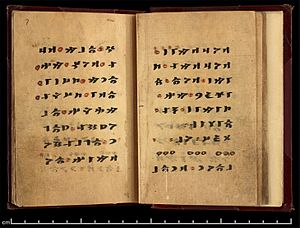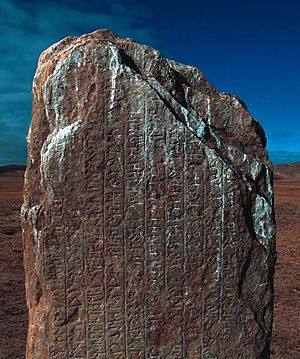Turkic languages facts for kids
Quick facts for kids Turkic |
|
|---|---|
| Ethnicity: | Turkic peoples |
| Geographic distribution: |
Central Asia East Asia North Asia Western Asia Eastern Europe Southern Europe |
| Linguistic classification: | One of the world's primary language families |
| Proto-language: | Proto-Turkic |
| Subdivisions: |
Shaz Turkic (Common Turkic)
Lir Turkic (Oghur)
|
| ISO 639-5: | trk |
 The distribution of the Turkic languages
|
|
The Turkic languages are a language family of at least 35 documented languages, spoken by the Turkic peoples of Eurasia from Eastern Europe and Southern Europe to Central Asia, East Asia, North Asia (Siberia), and Western Asia. The Turkic languages originated in a region of East Asia spanning from Mongolia to Northwest China, where Proto-Turkic is thought to have been spoken, from where they expanded to Central Asia and farther west during the first millennium. They are characterized as a dialect continuum.
Turkic languages are spoken natively by some 200 million people, and the total number of Turkic speakers, including second language speakers, is over 230 million. The Turkic language with the greatest number of speakers is Turkish, spoken mainly in Anatolia and the Balkans; its native speakers account for about 38% of all Turkic speakers.
Characteristic features such as vowel harmony, agglutination, subject-object-verb order, and lack of grammatical gender, are almost universal within the Turkic family. There is a high degree of mutual intelligibility, upon moderate exposure, among the various Oghuz languages, which include Turkish, Azerbaijani, Turkmen, Qashqai, Chaharmahali Turkic, Gagauz, and Balkan Gagauz Turkish, as well as Oghuz-influenced Crimean Tatar. Although methods of classification vary, the Turkic languages are usually considered to be divided equally into two branches: Oghur, the only surviving member of which is Chuvash, and Common Turkic, which includes all other Turkic languages including the Oghuz sub-branch.
Turkic languages show many similarities with the Mongolic, Tungusic, Koreanic, and Japonic languages. These similarities have led some linguists to propose an Altaic language family, though this proposal is widely rejected by Western historical linguists. Similarities with the Uralic languages even caused these families to be regarded as one for a long time under the Ural-Altaic hypothesis. However, there has not been sufficient evidence to conclude the existence of either of these macrofamilies, the shared characteristics between the languages being attributed presently to extensive prehistoric language contact.
Contents
History
Pre-history
The homeland of the Turkic peoples and their language is suggested to be somewhere between the Transcaspian steppe and Northeastern Asia (Manchuria), with genetic evidence pointing to the region near South Siberia and Mongolia as the "Inner Asian Homeland" of the Turkic ethnicity. Similarly several linguists, including Juha Janhunen, Roger Blench and Matthew Spriggs, suggest that modern-day Mongolia is the homeland of the early Turkic language. Relying on Proto-Turkic lexical items about the climate, topography, flora, fauna, people's modes of subsistence, Turkologist Peter Benjamin Golden locates the Proto-Turkic Urheimat in the southern, taiga-steppe zone of the Sayan-Altay region.
Extensive contact took place between Proto-Turks and Proto-Mongols approximately during the first millennium BC; the shared cultural tradition between the two Eurasian nomadic groups is called the "Turco-Mongol" tradition. The two groups shared a similar religion system, Tengrism, and there exists a multitude of evident loanwords between Turkic languages and Mongolic languages. Although the loans were bidirectional, today Turkic loanwords constitute the largest foreign component in Mongolian vocabulary.
Some lexical and extensive typological similarities between Turkic and the nearby Tungusic and Mongolic families, as well as the Korean and Japonic families has in more recent years been instead attributed to prehistoric contact amongst the group, sometimes referred to as the Northeast Asian sprachbund. A more recent (circa first millennium BC) contact between "core Altaic" (Turkic, Mongolic, and Tungusic) is distinguished from this, due to the existence of definitive common words that appear to have been mostly borrowed from Turkic into Mongolic, and later from Mongolic into Tungusic, as Turkic borrowings into Mongolic significantly outnumber Mongolic borrowings into Turkic, and Turkic and Tungusic do not share any words that do not also exist in Mongolic.
Turkic languages also show some Chinese loanwords that point to early contact during the time of Proto-Turkic.
Robbeets (et al. 2015 and et al. 2017) suggest that the homeland of the Turkic languages was somewhere in Manchuria, close to the Mongolic, Tungusic and Koreanic homeland (including the ancestor of Japonic), and that these languages share a common "Transeurasian" origin. More evidence for the proposed ancestral "Transeurasian" origin was presented by Nelson et al. 2020 and Li et al. 2020.
Early written records

The first established records of the Turkic languages are the eighth century AD Orkhon inscriptions by the Göktürks, recording the Old Turkic language, which were discovered in 1889 in the Orkhon Valley in Mongolia. The Compendium of the Turkic Dialects (Divânü Lügati't-Türk), written during the 11th century AD by Kaşgarlı Mahmud of the Kara-Khanid Khanate, constitutes an early linguistic treatment of the family. The Compendium is the first comprehensive dictionary of the Turkic languages and also includes the first known map of the Turkic speakers' geographical distribution. It mainly pertains to the Southwestern branch of the family.
The Codex Cumanicus (12th–13th centuries AD) concerning the Northwestern branch is another early linguistic manual, between the Kipchak language and Latin, used by the Catholic missionaries sent to the Western Cumans inhabiting a region corresponding to present-day Hungary and Romania. The earliest records of the language spoken by Volga Bulgars, the parent to today's Chuvash language, are dated to the 13th–14th centuries AD.
Geographical expansion and development

With the Turkic expansion during the Early Middle Ages (c. 6th–11th centuries AD), Turkic languages, in the course of just a few centuries, spread across Central Asia, from Siberia to the Mediterranean. Various terminologies from the Turkic languages have passed into Persian, Hindustani, Ukrainian, Russian, Chinese, Mongolian, Hungarian and to a lesser extent, Arabic.
The geographical distribution of Turkic-speaking peoples across Eurasia since the Ottoman era ranges from the North-East of Siberia to Turkey in the West. (See picture in the box on the right above.)
For centuries, the Turkic-speaking peoples have migrated extensively and intermingled continuously, and their languages have been influenced mutually and through contact with the surrounding languages, especially the Iranian, Slavic, and Mongolic languages.
This has obscured the historical developments within each language and/or language group, and as a result, there exist several systems to classify the Turkic languages. The modern genetic classification schemes for Turkic are still largely indebted to Samoilovich (1922).
The Turkic languages may be divided into six branches:
- Common Turkic
- Southwestern (Oghuz Turkic)
- Southeastern (Karluk Turkic)
- Northwestern (Kipchak Turkic)
- Northeastern (Siberian Turkic)
- Arghu Turkic
- Oghur Turkic
In this classification, Oghur Turkic is also referred to as Lir-Turkic, and the other branches are subsumed under the title of Shaz-Turkic or Common Turkic. It is not clear when these two major types of Turkic can be assumed to have diverged.
With less certainty, the Southwestern, Northwestern, Southeastern and Oghur groups may further be summarized as West Turkic, the Northeastern, Kyrgyz-Kipchak, and Arghu (Khalaj) groups as East Turkic.
Geographically and linguistically, the languages of the Northwestern and Southeastern subgroups belong to the central Turkic languages, while the Northeastern and Khalaj languages are the so-called peripheral languages.
Hruschka, et al. (2014) use computational phylogenetic methods to calculate a tree of Turkic based on phonological sound changes.
Other possible relations
The Turkic language family is currently regarded as one of the world's primary language families. Turkic is one of the main members of the controversial Altaic language family. There are some other theories about an external relationship but none of them are generally accepted.
Languages by native speakers
- Further information: Lists of endangered languages, List of endangered languages in Russia, and List of endangered languages in China
The Turkic languages are a language family of at least 35 documented languages, spoken by the Turkic peoples. The number of speakers derived from statistics or estimates (2019) and were rounded:
| Number | Name | Branch | Status | Native Speakers | Main Country | Main Writing System |
|---|---|---|---|---|---|---|
| 1 | Turkish language | Oghuz languages | Normal | 76,000,000 | Latin | |
| 2 | Uzbek language | Karluk languages | Normal | 35,000,000 | Latin | |
| 3 | Azerbaijani language | Oghuz languages | Normal | 30,000,000 | Latin | |
| 5 | Uyghur language | Karluk languages | Normal | 25,000,000 | Perso-Arabic | |
| 4 | Kazakh language | Kipchak languages | Normal | 19,000,000 | Latin | |
| 6 | Turkmen language | Oghuz languages | Normal | 7,000,000 | Latin | |
| 7 | Tatar language | Kipchak languages | Normal | 5,500,000 | Cyrillic | |
| 8 | Kyrgyz language | Kipchak languages | Normal | 5,000,000 | Cyrillic | |
| 9 | Bashkir language | Kipchak languages | Vulnerable | 1,500,000 | Cyrillic | |
| 10 | Chuvash language | Oghur languages | Vulnerable | 1,200,000 | Cyrillic | |
| 11 | Qashqai language | Oghuz languages | Normal | 1,000,000 | Perso-Arabic | |
| 12 | Khorasani Turkic language | Oghuz languages | Vulnerable | 1,000,000 | Perso-Arabic | |
| 13 | Karakalpak language | Kipchak languages | Normal | 650,000 | Latin | |
| 14 | Crimean Tatar language | Kipchak languages | Severely endangered | 600,000 | Latin | |
| 15 | Kumyk language | Kipchak languages | Vulnerable | 450,000 | Cyrillic | |
| 16 | Karachay-Balkar language | Kipchak languages | Vulnerable | 400,000 | Cyrillic | |
| 17 | Yakut language | Siberian Turkic languages | Vulnerable | 400,000 | Cyrillic | |
| 18 | Tuvan language | Siberian Turkic languages | Vulnerable | 300,000 | Cyrillic | |
| 19 | Urum language | Oghuz languages | Definitely endangered | 200,000 | Cyrillic | |
| 20 | Gagauz language | Oghuz languages | Critically endangered | 150,000 | Latin | |
| 21 | Siberian Tatar language | Kipchak languages | Definitely endangered | 100,000 | Cyrillic | |
| 22 | Nogai language | Kipchak languages | Definitely endangered | 100,000 | Cyrillic | |
| 23 | Salar language | Oghuz languages | Vulnerable | 70,000 | Latin | |
| 24 | Altai language | Siberian Turkic languages | Severely endangered | 60,000 | Cyrillic | |
| 25 | Khakas language | Siberian Turkic languages | Definitely endangered | 50,000 | Cyrillic | |
| 26 | Khalaj language | Arghu Turkic language | Vulnerable | 20,000 | Perso-Arabic | |
| 27 | Äynu language | Karluk languages | Critically endangered | 6,000 | Perso-Arabic | |
| 28 | Western Yugur language | Siberian Turkic languages | Severely endangered | 5,000 | Latin | |
| 29 | Shor language | Siberian Turkic languages | Severely endangered | 3,000 | Cyrillic | |
| 30 | Dolgan language | Siberian Turkic languages | Definitely endangered | 1,000 | Cyrillic | |
| 31 | Krymchak language | Kipchak languages | Critically endangered | 200 | Hebrew | |
| 32 | Ili Turki language | Karluk languages | Severely endangered | 100 | Cyrillic | |
| 33 | Tofa language | Siberian Turkic languages | Critically endangered | 100 | Cyrillic | |
| 34 | Karaim language | Kipchak languages | Critically endangered | 100 | Cyrillic | |
| 35 | Chulym language | Siberian Turkic languages | Critically endangered | 50 | Cyrillic | |
| Total | Turkic languages | Common Turkic languages | Normal | 179,000,000 | Latin |
See also
 In Spanish: Lenguas túrquicas para niños
In Spanish: Lenguas túrquicas para niños



